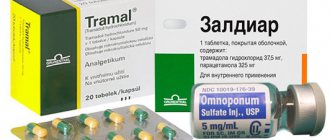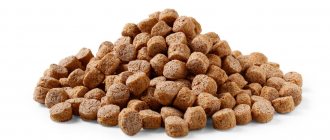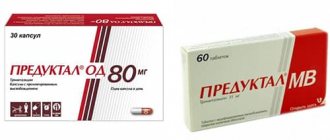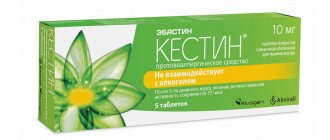Compound
1 tablet of Xefocam may contain 4 or 8 mg of the active ingredient lornoxicam and auxiliary components: povidone K25, magnesium stearate, cellulose, talc, croscarmellose sodium, lactose monohydrate, titanium dioxide, macrogol 6000 , hypromellose.
One bottle of Xefocam lyophilisate contains 8 mg of the active ingredient lornoxicam and auxiliary components: disodium edetate, trometamol, mannitol.
Release form
White oblong tablets (4 mg dosage) engraved with “LO4”.
- 10 pieces in a blister - 10, 1, 2, 3 or 5 blisters in a pack of paper.
White oblong tablets (dosage 8 mg) engraved with the inscription “LO8”.
- 10 pieces in a blister - 10, 1, 2, 3 or 5 blisters in a pack of paper.
The lyophilisate for making the solution is a dense yellow mass.
- 5 glass bottles in a paper pack.
- 5 glass bottles in a plastic tray; 1 pallet in a pack of paper.
Pharmacodynamics and pharmacokinetics
Pharmacodynamics
Anti-inflammatory non-steroidal drug. It has a pronounced analgesic and anti-inflammatory effect. Lornoxicam has a rather complex mechanism of action, which includes inhibition of prostaglandin synthesis caused by inhibition of cyclooxygenase activity. Blocking cyclooxygenase leads to suppression of peripheral pain receptors and relief of signs of inflammation.
Lornoxicam also reduces the production of oxygen radicals by leukocytes that have undergone activation. The analgesic effect of the drug is not associated with an opiate-like effect on the nervous system and is not accompanied by respiratory depression or drug dependence.
Does not affect important vital signs: respiratory rate, ECG readings, body temperature, heart rate, blood pressure, spirometry .
Pharmacokinetics of tablets
After oral administration, lornoxicam is quickly and completely absorbed from the intestine. In this case, the highest concentration in the blood occurs after an hour and a half. Eating reduces the maximum concentration by 30% and increases the half-life to 2.3 hours. The bioavailability of lornoxicam reaches 92-100%. Binding to blood proteins is 99% and does not depend on its content.
The active substance is completely transformed in the liver. The enzyme CYP2C9 is involved in the transformation . In plasma, the drug is present predominantly unchanged and, only to a small extent, in the form of a hydroxylated metabolite that does not have pharmacological activity.
The half-life is approximately 4 hours. About a third of the metabolites are excreted in the urine and the remainder in the bile.
In elderly people, as well as in patients with impaired liver and kidney function, no changes in the pharmacokinetics of the drug were detected.
Pharmacokinetics of solution for parenteral administration
When administered intramuscularly, the highest content of lornoxicam in the blood is achieved after 25 minutes. Bioavailability in this case reaches 97%, and the reaction with blood proteins is 99%.
Lornoxicam is found in plasma in unchanged form and also in the form of a hydroxylated metabolite that has no pharmacological activity.
The half-life is approximately 3.5 hours. Completely metabolized. About a third of the metabolites are excreted in the urine and the remainder in the bile.
In elderly people, as well as in patients with impaired liver and kidney function, no changes in the pharmacokinetics of the drug were detected.
How does Xefocam work?
The analgesic effect of Xefocam is higher than that of similar NSAID-based drugs. The active component of the drug blocks the release of pain and inflammatory mediators without having an antipyretic effect. Thanks to this, acute symptoms of diseases of the joints and spine are relieved.
The use of the drug does not cause disturbances in the central nervous system, does not change the level of blood pressure and heart rate. Xefocam does not accumulate in body tissues and does not provoke addiction or drug dependence, despite its strong symptomatic effect.
Unlike the tablet form, Xefocam injections reduce pain within 5–10 minutes. The effect of one dose lasts for 0.5–1 day. In addition, parenteral administration of the drug reduces the risk of irritation of the gastric mucosa.
The transformation of Xefocam occurs in the liver. Part of the active substance remains unmetabolized and is excreted through the kidneys. Residues of NSAIDs leave the body with intestinal contents within 24 hours. In people with reduced liver function, the duration of drug elimination is prolonged.
Indications for use
Indications for use of Xefocam in tablet form:
- short-term therapy of pain syndrome, regardless of origin;
- symptomatic treatment of rheumatic diseases: nylosing spondylitis , osteoarthritis , articular syndrome in acute gout , rheumatoid arthritis , rheumatic lesions of periarticular soft tissues.
The drug is used in the form of injections for short-term treatment of acute pain of a moderate, mild and moderately severe nature.
For what pathologies is Xefocam indicated?
Injections are prescribed intramuscularly and intravenously to eliminate the inflammatory process and acute pain:
- during attacks of lumbodynia caused by intervertebral hernias, pinched nerve endings of the spine, exacerbations of osteochondrosis, spondyloarthrosis;
- for sciatica;
- with neuralgic attacks;
- for injuries of the vertebrae and joints;
- during the recovery period after surgery;
- for chronic symptoms of rheumatism, osteoarthritis and arthritis of various origins.
Xefocam does not affect the general course of the disease, but significantly improves the physical condition, reducing acute pain and restoring the limited mobility of the musculoskeletal system.
Contraindications
- combination (complete or incomplete) of polyposis of the paranasal sinuses or nose, bronchial asthma and intolerance to non-steroidal anti-inflammatory drugs (including a history);
- thrombocytopenia;
- bleeding diathesis or bleeding disorders, including conditions after surgical interventions associated with the likelihood of bleeding or insufficient hemostasis;
- the period after undergoing coronary artery bypass surgery ;
- changes in the mucous membranes of the duodenum or stomach of the erosive-ulcerative type, active bleeding from the gastrointestinal tract, as well as cerebrovascular or other bleeding;
- previous bleeding from the digestive organs associated with taking non-steroidal anti-inflammatory drugs;
- recurrent stomach ulcers or repeated bleeding from the digestive system;
- exacerbation of inflammatory bowel disease ( Crohn's disease );
- decompensated heart failure;
- liver failure or active liver disease;
- severe renal failure , progressive kidney disease, hyperkalemia , dehydration or hypovolemia ;
- pregnancy and lactation;
- age less than 18 years;
- allergy to the components of the drug.
Caution should be exercised in prescribing the medicine in the presence of at least one of the following conditions: lesions of the digestive tract of an erosive-ulcerative nature and bleeding of the specified localization, moderate renal failure, conditions after surgery, arterial hypertension , age over 65 years, coronary heart disease , cerebrovascular diseases , chronic cardiac failure, dyslipidemia , peripheral arterial disease, diabetes mellitus , smoking, creatinine clearance up to 60 ml/min, the presence of Helicobacter pylori, ulcerative lesions of the digestive tract in the past, long-term use of anti-inflammatory non-steroidal drugs, severe somatic diseases, alcoholism , joint taking oral forms of glucocorticosteroids, anticoagulants, antiplatelet agents, diuretics, selective serotonin uptake blockers or drugs with nephrotoxic effects.
Concomitant therapy with anti-inflammatory nonsteroidal drugs and Tacrolimus may increase the risk of nephrotoxicity.
The simultaneous use of anti-inflammatory non-steroidal drugs and Heparin against the background of epidural or spinal anesthesia increases the likelihood of epidural and spinal hematomas .
Composition and pharmaceutical form
The active substance of the drug is lornoxicam, which belongs to the group of non-steroidal anti-inflammatory drugs. The drug has a pronounced analgesic effect without affecting the thermoregulation centers and the cardiovascular system.
Xefocam is produced in the form of a lyophilized powder, soluble in water. The light yellow dense mass is packaged in dark glass bottles. One dose of the drug contains 8 mg of lornoxicam and stabilizing additives, including mannitol, trometamol. When combined with a liquid, the drug is converted into a homogeneous colored solution.
The injections are intended for parenteral administration: intravenously and intramuscularly. One cardboard package of Xefocam contains 5 bottles of lyophilized dry mass.
Side effects
The most common adverse reactions to taking non-steroidal anti-inflammatory drugs are: the appearance of peptic ulcers , perforation of a hollow organ or bleeding of the gastrointestinal localization. Also noted are abdominal pain, vomiting, nausea, diarrhea, constipation, flatulence , dyspepsia , hematemesis , melena , exacerbation of colitis , ulcerative stomatitis , exacerbation of Crohn's disease , gastritis . Approximately 20% of patients taking this medication may develop adverse reactions.
- reactions from hematopoiesis: anemia , leukopenia , thrombocytopenia , increased duration of bleeding, ecchymosis ;
- reactions from the immune system: allergies;
- metabolic reactions: anorexia , weight gain or loss;
- mental reactions: depression , sleep disturbance, nervousness, confusion, anxious agitation;
- reactions from nervous activity: temporary mild headaches, dizziness, paresthesia , somnolence , tremor , taste disturbance, migraine ;
- reactions from vision: conjunctivitis , blurred vision;
- reactions from the vestibular apparatus: tinnitus, dizziness ;
- reactions from the circulation: tachycardia , palpitations, heart failure , edema, hot flashes , hemorrhages, arterial hypertension , hematoma ;
- reactions from the respiratory organs: rhinitis , dyspnea , pharyngitis , bronchospasm , cough;
- digestive reactions: abdominal pain, nausea, dyspepsia , vomiting , , flatulence , constipation, dry mouth, belching, peptic ulcer , gastritis , ulcerations in the oral mucosa, hematemesis, glossitis , melena , stomatitis , gastroesophageal reflux , esophagitis , aphthous stomatitis , dysphagia , perforated ulcer ;
- reactions from the hepatobiliary system: increased concentrations of glutamate-pyruvate transaminase and glutamate-oxaloacetate transaminase, damage to hepatocytes, impaired liver function;
- skin reactions: itching, rash, sweating, urticaria , dermatitis , alopecia , purpura , bullous reactions, edema, epidermal toxic necrolysis , Stevens-Johnson syndrome ;
- reactions from the musculoskeletal system: arthralgia , muscle spasms, bone pain, myalgia ;
- reactions from the urinary system: urinary disorders, nocturia , increased concentration of urea or creatinine in the blood;
- general reactions: facial swelling , malaise, asthenia .
Xefocam lyophilisate (solution)
In each particular category, side effects are grouped by system-organ class and presented in descending order of frequency: very often (≥ 1/10); often (≥ 1/100 to < 1/10); uncommon (≥ 1/1000 to < 1/100); rare (≥ 1/10,000 to < 1/1000); very rare (< 1/10,000), unknown (cannot be estimated based on available data).
Infectious and parasitic diseases
Rarely: pharyngitis.
Blood and lymphatic system disorders
Rarely: anemia, thrombocytopenia, leukopenia, increased bleeding time.
Very rare: ecchymosis. NSAIDs have been reported to cause potentially severe hematological disorders, such as neutropenia, agranulocytosis, aplastic anemia and hemolytic anemia (class-specific effects).
Immune system disorders
Rarely: hypersensitivity, anaphylactoid and anaphylactic reactions.
Metabolic and nutritional disorders
Uncommon: anorexia, weight change.
Mental disorders
Uncommon: sleep disturbance, depression.
Rarely: confusion, nervousness, agitation.
Nervous system disorders
Often: short-term headaches of low intensity, dizziness.
Rarely: somnolence, paresthesia, taste disturbance, tremor, migraine.
Very rare: aseptic meningitis in patients with SLE and mixed connective tissue diseases.
Visual disorders
Uncommon: conjunctivitis.
Rarely: visual disturbances.
Hearing and labyrinth disorders
Uncommon: dizziness, tinnitus.
Heart disorders
Uncommon: palpitations, tachycardia, edema, heart failure.
Vascular disorders
Uncommon: flushing of the face, swelling.
Rarely: arterial hypertension, bleeding, hematoma.
Respiratory, thoracic and mediastinal disorders
Uncommon: rhinitis.
Rarely: dyspnea, cough, bronchospasm.
Gastrointestinal disorders
Common: nausea, abdominal pain, dyspepsia, diarrhea, vomiting.
Uncommon: constipation, flatulence, belching, dry mouth, gastritis, gastric ulcer, epigastric pain, duodenal ulcer, oral ulceration.
Rarely: melena, hematemesis, stomatitis, esophagitis, gastroesophageal reflux, dysphagia, aphthous stomatitis, glossitis, perforated peptic ulcer, gastrointestinal bleeding.
Disorders of the liver and biliary tract
Uncommon: increased liver function tests, alanine aminotransferase (ALT) or aspartate aminotransferase (AST).
Rarely: liver dysfunction.
Very rare: damage to hepatocytes. Hepatotoxicity, which can lead to liver failure, hepatitis, jaundice and cholestasis.
Skin and subcutaneous tissue disorders
Uncommon: rash, itching, sweating, erythematous rash, urticaria, Quincke's edema, alopecia.
Rarely: dermatitis and eczema, purpura.
Very rare: edema, bullous reactions, Stevens-Johnson syndrome, toxic epidermal necrolysis.
Musculoskeletal and connective tissue disorders
Uncommon: arthralgia.
Rarely: bone pain, muscle spasms, myalgia.
Renal and urinary tract disorders
Rarely: nocturia, urinary disorders, increased levels of urea and creatinine in the blood.
Very rare: In patients with pre-existing renal impairment who require renal prostaglandins to maintain renal blood flow, lornoxicam may precipitate acute renal failure. Nephrotoxicity in various forms, including nephritis and nephrotic syndrome, is a class-specific effect of NSAIDs.
General and administration site disorders
Uncommon: malaise, facial swelling.
Rarely: asthenia.
Instructions for use of Xefocam (Method and dosage)
Xefocam tablets, instructions for use
The medicine is taken orally before meals with 100 ml of water.
For moderate to severe pain, the drug is taken in a dose of 8-16 mg per day, divided into 2-3 doses. The maximum daily dose is 16 mg.
For rheumatic diseases of an inflammatory-degenerative nature, 12 mg is recommended as the initial dose. The usual daily dose is 8-16 mg.
The exact dose selection is carried out by the doctor based on the patient’s condition, and the duration of treatment depends on the clinic and the course of the disease.
For damage to the digestive organs, for persons with impaired kidney or liver function, for elderly patients or after major operations, the maximum daily dose is set at 12 mg of the drug per day, divided into 3 doses.
To reduce the likelihood of adverse events, the minimum effective dose should be prescribed for the shortest course.
Xefocam injections, instructions for use
Injections are used only parenterally.
When treating pain after surgery, Xefocam injections are given intravenously or intramuscularly, when treating acute lumbago or ischalgia - only intramuscularly.
The initial injection dose may be 8 or 16 mg. If the analgesic effect is weak after administration of 8 mg of the drug, it is allowed to additionally administer another identical dose.
Injections of medication used as maintenance therapy are prescribed at a dose of 8 mg twice a day. The maximum daily dosage is 16 mg.
Injections should be administered at the minimum effective dose in the shortest possible course.
A solution for parenteral administration is prepared before use by dissolving the contents of the bottle with 2 ml of water for injection. The needle is then replaced. Intramuscular injections are made only with a long needle. The drug solution prepared in the described manner is administered intramuscularly or intravenously. The duration of the injection with the intravenous method should be more than 15 seconds, with the intramuscular method - more than 5 seconds.
Method of using Xefocam injections: instructions
The injection solution is prepared immediately before use. The dose of the drug from the bottle is diluted in 2 ml of distilled water. Use syringes with a long needle.
- With an intramuscular injection, the administration of the medicine lasts 5 seconds;
- intravenous administration should last at least 15 seconds.
The daily dose of the drug is 8–16 mg. In case of particularly acute pain, an additional single injection is allowed. The break between injections should be at least 9 hours.
Course of treatment with Xefocam: up to 5 days. For moderate pain, it is recommended to reduce it to 2-3 days. A single injection of the solution without repeating injections is possible in case of unexpectedly developing attacks of pain and in subacute conditions.
Overdose
In case of an overdose of the drug, the following symptoms are possible: dizziness, nausea and vomiting, ataxia , visual disturbances, convulsions , coma . Changes in the liver and kidneys, as well as blood clotting disorders, are possible.
Treatment of overdose: Stop administering or taking the medication. Lornoxicam is quickly evacuated from the body. Dialysis is ineffective. A selective antidote is not known. In case of poisoning with tablets, emergency measures must be taken, including taking enterosorbents and gastric lavage. Ranitidine or prostaglandin are allowed to be used for the treatment of digestive disorders .
Interaction
When used together with Cimetidine, the concentration of lornoxicam in the blood increases.
When used simultaneously with anticoagulants or platelet aggregation blockers, it is possible that the duration of bleeding may increase and the likelihood of bleeding may increase.
Combined use with Phenprocoumon reduces its therapeutic effectiveness.
When taking anti-inflammatory nonsteroidal drugs along with Heparin during spinal or epidural anesthesia, the risk of spinal and epidural hematomas increases.
When used together with ACE blockers and beta-blockers, their hypotensive effect is reduced.
The drug weakens the hypotensive and diuretic effect of diuretics, and also reduces the clearance of Digoxin .
When used together with other anti-inflammatory non-steroidal drugs or glucocorticosteroids, the risk of bleeding from the digestive organs increases.
When used together with quinoline antibiotics, the risk of seizure syndrome increases.
The drug increases the level of methotrexate in the blood when used together.
When used simultaneously with selective serotonin uptake blockers, the risk of bleeding from the digestive organs increases.
Xefocam can cause an increase in the concentration of lithium in the blood, increasing the side effects of the latter when taken together.
Xefocam stimulates the nephrotoxic effects of Cyclosporine and the hypoglycemic effect of sulfonylurea drugs.
When taken together with potassium supplements, corticotropin , alcohol, the risk of undesirable effects on the digestive system increases.
When used simultaneously with Cefotetan , Cefoperazone , Cefamandole , and valproic acid, the likelihood of bleeding increases.
When taken together with Tacrolimus , the risk of nephrotoxicity increases.
special instructions
The likelihood of an ulcerogenic effect of the drug can be reduced by simultaneous use of proton pump inhibitors and artificial prostaglandin analogues. If bleeding from the digestive organs occurs, the medication must be stopped immediately and emergency measures must be taken. It is especially necessary to carefully monitor patients with pathologies of the gastrointestinal tract who are taking the drug for the first time.
Like any other oxicams, the described drug inhibits platelet aggregation, which causes an increase in the duration of bleeding. When using the drug, the condition of patients who require normal physiological functioning of the coagulation system (including those who are planning to undergo surgery), who have blood clotting disorders, or who are taking medications that suppress coagulation, should be carefully monitored in order to promptly identify signs of bleeding .
If signs of liver damage are detected (yellowness of the skin, itching, vomiting, nausea, dark urine, abdominal pain, increased levels of liver transaminases), you should immediately stop using the medication and consult a doctor.
It is prohibited to use the medicine simultaneously with other anti-inflammatory non-steroidal drugs.
Xefocam is able to change the properties of platelets, but it does not replace the preventive effect of Aspirin for cardiovascular disorders.
For patients with impaired renal function caused by severe blood loss or dehydration, the drug, as an inhibitor of prostaglandin biosynthesis, is allowed to be prescribed only after relief of hypovolemia and the resulting risk of decreased renal perfusion.
The described medicine can cause an increase in urea and creatinine in the blood, as well as sodium and water retention, arterial hypertension , peripheral edema and some other initial symptoms of nephropathy . Long-term therapy of such patients with Xefocam can cause glomerulonephritis , nephrotic syndrome and even acute kidney failure.
In elderly people, as well as those suffering from arterial hypertension or obesity , blood pressure should be monitored.
It is especially important to monitor renal function in elderly patients, as well as in persons concomitantly taking diuretics or drugs that potentially cause damage to kidney tissue.
With long-term use of the drug, it is necessary to regularly monitor hematological parameters, as well as kidney and liver parameters.
Persons receiving the drug are strongly advised to refrain from driving and drinking alcohol.
Side effects and contraindications
With short-term use of Xefocam, adverse reactions to it rarely develop. Among the possible:
- dyspepsia: loss of appetite, nausea, discomfort and pain in the stomach;
- visual impairment;
- decreased sensitivity of various parts of the body;
- tremor;
- dizziness;
- asthenia, physical weakness;
- change in blood formula;
- increased liver transaminases;
- decrease in diuresis.
People with dysfunction of internal organs have a higher risk of side effects; they need to reduce the dosage of the drug and monitor laboratory parameters.
It is necessary to stop using Xefocam for the following diseases and conditions:
- gastric ulcer and ulcerative colitis;
- tendency to internal bleeding;
- severe liver or kidney failure;
- with hematopoietic disorders, insufficient hemostasis;
- during the recovery period after internal organ transplantation;
- with severe heart failure;
- with Crohn's disease.
It is also not recommended to use Xefocam during pregnancy, as it can negatively affect the development of the fetus, increases the risk of premature placental abruption, and complicates the birth process. Nursing mothers, children and adolescents under 18 years of age need to choose less strong painkillers due to the imperfections of the young body.
Analogues of Xefocam
Level 4 ATX code matches:
Mirlox
Revmoxicam
Xefocam Rapid
Movalis
Mesipol
Lem
Melbek
Movasin
Piroxicam
Lornoxicam
Arthrozan
Texamen
Amelotex
Meloxicam
- Zornica
- Xefocam Rapid
- Larfix
- Lorakam
- Aroxicam
- Aspikam
- Loxidol
- Melbek
- Meloxicam
- Revmalim
- Rekoksa
The price of Xefocam analogues, which are listed above, is in almost all cases higher than the price of Xefokam itself.
Xefocam price, where to buy
The price of Xefocam in tablets of 8 mg No. 10 in Russia is about 250 rubles. For comparison, the price of 5 ampoules with lyophilisate is approximately 800 rubles.
Buying Xefocam 8 mg No. 10 in Ukraine will cost an average of 100 hryvnia, and the price of Xefocam No. 5 injections reaches 450 hryvnia.
- Online pharmacies in RussiaRussia
- Online pharmacies in UkraineUkraine
- Online pharmacies in KazakhstanKazakhstan
ZdravCity
- Xefocam tablets p.p.o.
8 mg 10 pcs. Takeda GmbH RUB 245 order - Xefocam tablets p.p.o. 8 mg 30 pcs. Takeda GmbH
512 rub. order
- Xefocam liof. d/prig. solution for intravenous and intramuscular injection. 8mg vial. 5pcs Wasserburger Arzneumittelwerk GmbH
RUR 783 order
Pharmacy Dialogue
- Xefocam (tablet p/o 8 mg No. 10)Takeda
RUB 237 order
- Xefocam (vial 8 mg No. 5)Wasserburger
RUR 767 order
- Xefocam (tab.p.pl/vol.8mg No. 30)Takeda
516 RUR order
show more
Pharmacy24
- Xefocam 8 mg No. 10 tablets Nycomed Austria GmbH.Austria/Nycomed Austria GmbH.Austria,Nimechchina/Takeda GmbH, Nimechchina
94 UAH.order - Xefocam 4 mg N10 tablets Takeda GmbH, city of Vir-va Oranienburg, Germany
59 UAH order
- Xefocam 8 mg No. 5 lyophilisate Nycomed Austria GmbH.Austria/Takeda Austria GmbH,Austria
446 UAH. order
PaniPharmacy
- Xefocam tablets Xefokam tablets. p/o 8 mg No. 10 Germany, Takeda
110 UAH order
- Ksefokam bottle Ksefokam por. d/in. 8ml fl. No.5 Austria, Takeda Austria
481 UAH order
- Xefocam tablets Xefokam tablets. p/o 4 mg No. 10 Germany, Takeda
75 UAH order
show more






